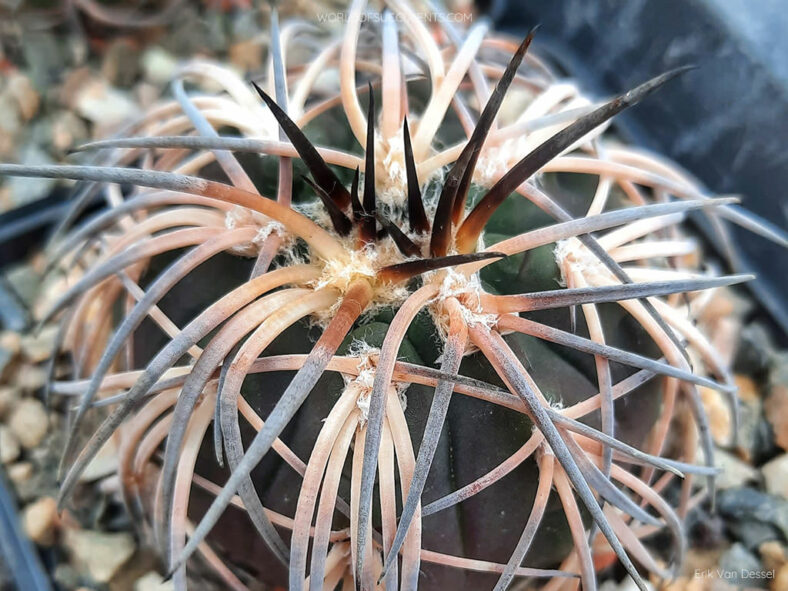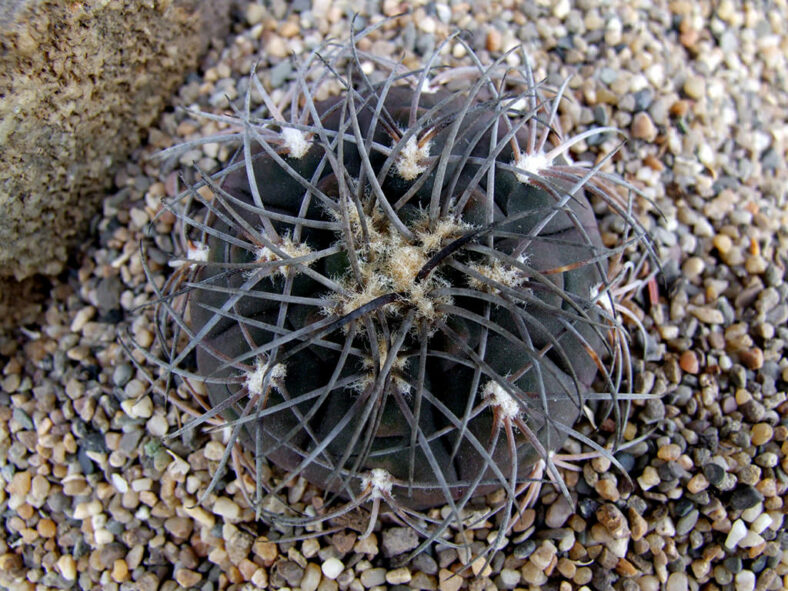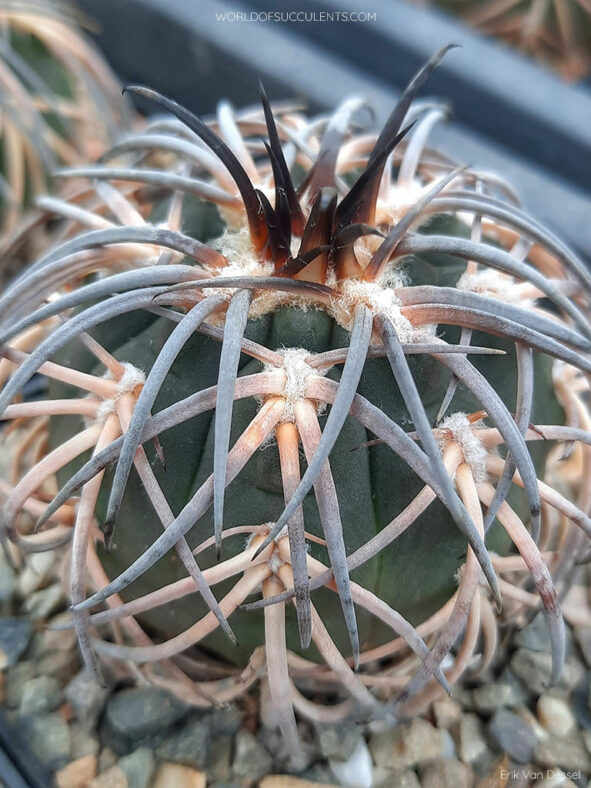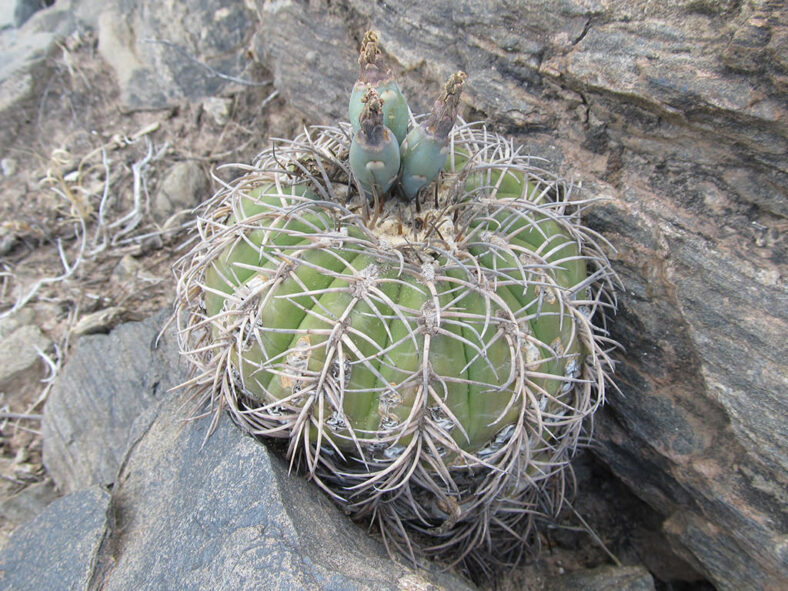Gymnocalycium spegazzinii is a small, slow-growing, first described in 1922 by Nathaniel Lord Britton and Joseph Nelson Rose.
Scientific Name
Gymnocalycium spegazzinii Britton & Rose
Synonym(s)
Echinocactus loricatus, Gymnocalycium loricatum, Gymnocalycium spegazzinii subsp. spegazzinii
Scientific Classification
Family: Cactaceae
Subfamily: Cactoideae
Tribe: Trichocereeae
Genus: Gymnocalycium
Etymology
The specific epithet "spegazzinii (speg-uh-ZIN-ee-eye)" honors Carlo Luigi Spegazzini (1858-1926), an Italian-born Argentinian botanist and mycologist who discovered the species.
Origin
Gymnocalycium spegazzinii is native to northwestern Argentina and Bolivia. It grows at elevations ranging from 4,920 to 9,840 feet (1,500 to 3,000 m).
Description
Gymnocalycium spegazzinii is a small cactus with a gray-green to brownish or almost black stem that cages itself in its long, stiff spines. The stem is spherical with a woolly, slightly depressed top and can grow up to 4.8 inches (12 cm) tall and 8 inches (20 cm) in diameter. It usually has 10 to 33 wide ribs somewhat furrowed between the woolly areoles. The spines are initially yellowish or blackish but turn brownish-gray with age, reaching up to 2.2 inches (5.5 cm) in length. They are curved, pointed downwards, and adpressed towards the stem. Each areole bears 5 to 9 radial spines, and the central spines are absent. In the wild, this cactus grows partially buried.
In late spring, Gymnocalycium spegazzinii produces funnel-shaped flowers from the areoles near the top of the stem. The flowers last about two weeks and can reach up to 2.8 inches (7 cm) in length and 2 inches (5 cm) in diameter. They have almost spoon-shaped, whitish to rosy outer tepals with an olive green midstripe and smaller, white, lance-shaped inner tepals with a pink midstripe and a carmine base. The fruits are oblong, powdery blue with a few rounded scales, and contain dark brown to black seeds. They can grow up to 1.4 inches (3.5 cm) long.

How to Grow and Care for Gymnocalycium spegazzinii
Light: During the hottest months, this cactus needs some protection from direct sunlight. However, excessive shading will result in the loss of flowers.
Soil: Having soil with good drainage is most important for a healthy Gymnocalycium spegazzinii. You can use commercial soil for cacti or make your own mix.
Temperature: This cactus can tolerate high temperatures but is not a cold-hardy plant. So, if there is a risk of freezing temperatures, bring it indoors. It grows best in USDA Plant Hardiness Zones 9b to 11b, with average minimum winter temperatures ranging from 25 to 50 °F (-3.9 to 10 °C).
Watering: During the growing season, water Gymnocalycium spegazzinii frequently, but allow the soil to completely dry out before watering again. In the winter, when it goes dormant, cut back on watering.
Fertilizing: While it does not need much fertilizing, giving it some extra nutrients occasionally keeps the plant healthy and prolongs the time for repotting. During the winter, there is no need to fertilize, as the plant is not actively growing.
Repotting: Repot it every two years into a pot that is the same size or slightly larger. The best time for repotting is in late winter or early spring.
Propagation: Since it rarely produces offsets, Gymnocalycium spegazzinii is usually propagated by seed. From late spring to early summer is the ideal time for sowing seeds.
Learn more at How to Grow and Care for Gymnocalycium.
Toxicity of Gymnocalycium spegazzinii
Gymnocalycium spegazzinii has no toxic effects reported. However, keep it away from pets and children as it has sharp spines.
Forms of Gymnocalycium spegazzinii
Links
- Back to genus Gymnocalycium
- Succupedia: Browse succulents by Scientific Name, Common Name, Genus, Family, USDA Hardiness Zone, Origin, or cacti by Genus
Photo Gallery
Click on a photo to see a larger version.



